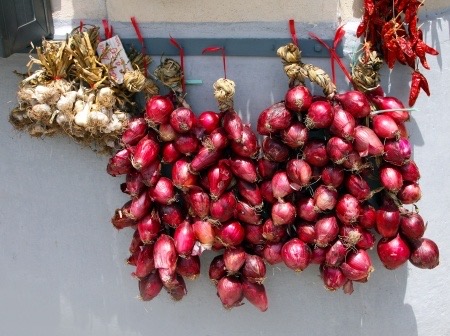The Violet Coast: Tropea and Capo Vaticano
If you are lucky enough to be driving south along the the Tyrrhenian coast, at sundown, you will witness a spectacle like no other: the Mediterranean sun descending above the sea becomes an orange red,—- much the same as the over-ripe blood oranges that have suddenly become so popular in our supermarkets around Christmas time—-and given that the sea along this stretch of coastline is a magical turqoise blue, the meeting of sun and sea, when it happens, sheathes the world in a spellbinding violet hue. For two hours, or so, the landscape is washed in an otherwordly violet tinge. Nothing equals this splendour; no coastline of Italy’s many beautiful ones can produce such magic!

And, as if to complete this strange symbiotic experience between sun sea and land, a sweet perfume punctuates the air from the orchards of bergamot which dot the landscape along on our way to Tropea.
If Calabria is generally unknown to the vast travelling masses, Tropea is at least beginning to open up to tourism. Its beaches’ pristine white sand, the timeworn but still charming town, its robust, southern cuisine are the elements that are now drawing more visitors to its doorstep. Here is a town, perilously hanging on the great cliffs that hang over the Mediterranean, that has all the ingredients for an alluring and saught after tourist mecca; and yet, little English is heard here among the visitors. Indeed, few other languages break the chatty buzz of tourists wandering about in Tropea’s piazzas.Those that come here are mostly Italians searching for the “southern” experience and new places to discover in the homeland.
Tropea was miraculously spared the devastation of the many earthquakes that have beset this part of the Italian peninsula. At one time, it was an important hub in the Mediterranean that welcomed the many peoples that throughout history dropped anchor here. Hercules, it is said, founded this town that looks out to the sea and to the volcanic Aeolians in the distance. Perhaps the most dramatic site opposite the centre of Tropea is the large rock outcrop jutting into the Tyrrhenian. This was once an island and the attractive monastery on the summit, Santa Maria dell’Isola, sits in gardens above the sea.
Lacking in the usual tourist amenities and the glitz and contrived appeal of other tourist towns of Italy, Tropea, instead, manifests an innocent “disinvoltura” or unconcerned cheerfulness at the simple things it has to offer: the syrupy fragrance of overripened figs; its world famous onions “Cipolle di Tropea”, heard sizzling in frying pans through open kitchen doorways; the pungent scent of caper bushes peaking through the crannies of ancient walls. The sun, the sea, the sky.
While the type of accomodation that well-travelled people are accustomed to is relatively scarse in Tropea, one exceptionally lovely resort exists: Villa Paola is a sixteenth century convent turned five star resort which sits in the most extrordinary of places: tucked away on the hill facing Tropea. Looking out to the sea at sunset with a cocktail in hand at the terrace bar is just short of paradise.

The Villa sits amid a continuous alternation of tiered gardens filled with citrus trees, maritime pines and palms, jasmine, and fuschia coloured bougainvillea. To visit and find a quiet moment in this oasis is to enter into the Garden of Eden.
The town of Tropea is very much like a “grande dame” of a past nobility; it retains a regal, timeless charm, albeit somewhat haggard and fading. The many churches, glorious palazzi, and splendid and imposing portals throughout the town centre attest to its once stately distiction. Rambling around the maze-like lanes and streets inevitably leads to an unexpectely pleasant piazza, dominated by a church and a few small restaurants from which waft titillating aromas. Usually, hanging outside its doors, or swinging from the umbrellas over the tables, are strings of red onions, for which Tropea is known. Fried, sun dried or baked, the cipolle di Tropea make for hearty, fiery—much like the Calabrians themselves– meals. Definitely worth a taste.


photo:italyheaven.co.uk


photo courtesy of: villino eleonora
A walk along the Corso Vittorio Emanuele to the railing overlooking the sea is the ritual “passeggiata” and main social activity of Tropea. A stop for a drink or gelato follows, and then…. another circuit is a must.

photo from: noleggiobarchetropea.it
Further down the Costa Degli Dei or The Coast of the Gods is Capo Vaticano. Travelling towards it along this coast one finds varied landscapes of a unique beauty and unspoilt nature: a succession of sandy shores and sheer cliffs; vistas that open suddenly and majestically to beautiful bays and lovely beaches lapped by a clear blue sea that is constantly changing, ranging from blue to turquoise to indigo.
Capo Vaticano is located on the tip of a promontory that juts out into the southern Tyrrhenian Sea towards Stromboli and the other Aeolian Islands.
Here again is a place that has little to boast when it comes to tourist attractions: a few simple accomodations for visitors and several small traditional shops where visitors can purchase local handicrafts made by the village artisans is the extent of this Calabrian town’s concession to tourism. Afterall, what else can be offered the visitor to this part of Calabria that might compete with its exceptional natural beauty, with the dramatic rock formations of its coasts and with its many small bays and isolated white sandy beaches? Not much.

photo, courtesy of pitrs






